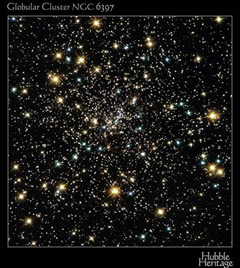Blue Stragglers
Blue stragglers are a class of star observed in old, dense stellar systems such as globular clusters. They stand out because old stellar populations are expected to be devoid of blue (high-mass) stars which possess very short lifespans. The blue stragglers in an old stellar population must therefore have formed long after the system as a whole.
A clue to their origin is that they are only found in dense stellar systems, where distances between stars are extremely small (a fraction of a light year). In these dense environments (for example the cores of globular clusters), collisions between stars are relatively common, and it has long been believed that blue stragglers are the result of the merger of two old, red stars. This merger produces a star with a greater mass (hence bluer in colour), and severely disrupts the two stars involved, mixing hydrogen into the stellar core and giving the star a new lease on life.
This model for the formation of blue stragglers was confirmed through observations of the nearby globular cluster, 47 Tucanae, taken with the Hubble Space Telescope. These observations showed that one of the blue stragglers (BSS 19) has a mass almost twice that of the normal stars in the cluster, and an extraordinarily high rotation rate at 75 times faster than that of the Sun. Both the high mass and the rapid rotation of this star bears witness to its origin in a stellar merger event.
Study Astronomy Online at Swinburne University
All material is © Swinburne University of Technology except where indicated.


